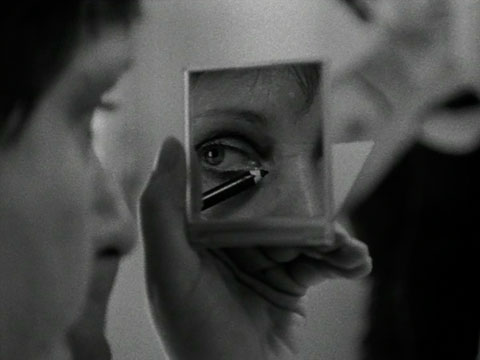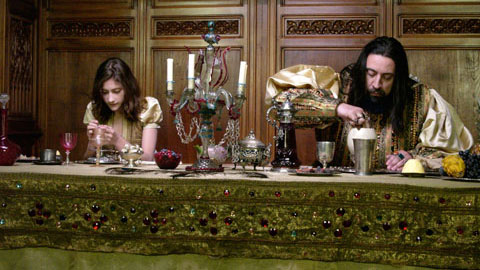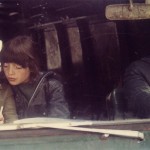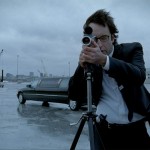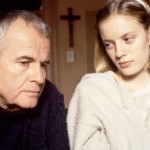Dir. by Ashley McKenzie
– – –
This essay was originally published at Metrograph.
– – –
Near the end of the first act of Tony Kushner’s 1991 play Angels in America, Prior Walter, a gay man recently diagnosed with AIDS, sits alone on stage in front of a dressing mirror and applies make-up to his face in “the new fall colors” he lifted from the Clinique counter at Macy’s. It’s a comically failed attempt to boost his spirits. “I look like a corpse. A corpsette,” he says. “Oh my queen; you know you’ve hit rock-bottom when even drag is a drag.” Hold for audience applause. And then, miraculously, Harper Pitt appears. When last we saw Harper, she had taken too many Valium, as is her habit—a byproduct of her marriage to the gaslighting Joe, a closeted Mormon on the fast track in the Reagan administration. “What are you doing in my hallucination?” Harper asks Prior. “I’m not in your hallucination. You’re in my dream,” he replies. It’s one of the great scenes of American theater. Prior and Harper immediately recognize the other’s suffering and sadness, and in each other’s presence are somehow both able—again, miraculously—to experience something akin to grace.
Harper: Deep inside you, there’s a part of you, the most inner part, entirely free of disease. I can see that.
Prior: Is that… That isn’t true.
Harper: Threshold of revelation.
Angels in America is subtitled “A Gay Fantasia on National Themes,” which could be applied as well to Queens of the Qing Dynasty, Ashley McKenzie’s quixotic film about a “queer friendship romance” between a suicidal young woman and a non-binary Chinese immigrant whom she meets while hospitalized. The magic of Angels in America is found somewhere in that notion of the “fantasia”—in the plays’ swirling, outrageous harmonizing of poetry, camp, comedy, embodied tragedy, beauty, political outrage, and self-aware theatrical illusion. (In Kushner’s words, “It’s okay if the wires show.”) McKenzie’s film is similarly fearless in its ambitions and in its sense of play. Shot on location in Cape Breton Island, Nova Scotia, on a small budget and with mostly untrained actors, Queens of the Qing Dynasty is nonetheless a big movie—cinematic, imaginative, startlingly uninhibited, and dense with ideas. Forgive the overwrought comparison to Angels, but the Pulitzer Prize-winning play is a useful precedent for reckoning with what McKenzie has accomplished here.
When we first meet Star (Sarah Walker), she’s in an emergency room, sipping from a bottle of activated charcoal to counteract whatever poison she swallowed this time. She’s days away from turning 19, at which point she’ll age out of Canadian child protective services and be forced to confront the prospect of living independently or risk being assigned to a group home. It’s a precarious situation. Her life in recent years has been marked by trauma, by mental health crises, and by a steady stream of bureaucratic encounters with social workers, guardians, and the doctors, nurses, and hospital orderlies who all know her by name. (When a character scrolls through Star’s Instagram grid, they mostly see pictures of other hospital rooms.) McKenzie drops us immediately into the chaos of Star’s everyday existence by shooting in tight closeups, with wide lenses that distort perspective, funhouse-mirror style. As the team around Star monitors her vitals and prods her to keep sipping, McKenzie cuts to Star’s point of view, and the voices that surround her are drowned out by the electronic score. Barely two minutes in, Star (and the film itself) is already disassociating.
Meanwhile, in a quieter corner of the hospital, a kind and sympathetic nurse prepares An (Ziyin Zheng) for their first meeting with Star: “You have to act as their advocate. Make sure they follow the rules,” he tells An. “She’s 18, and she has a disability.” An has emigrated to the isolated community of Cape Breton to attend graduate school and to pursue a new, more openly queer life. Volunteering as a companion at the hospital is just one more step on their long path toward Canadian citizenship. Our first glimpse of An is a closeup of their long, pointed acrylic fingernails, which dance and sway in time with An’s falsetto voice. They’re singing a traditional Chinese melody for the nurse, who looks on with fascination before sharing a song of his own. (This is the kind of movie where two characters sing to each other without any clear reason for doing so, and it’s simultaneously funny, strange, and sincerely moving.) An wears a neatly fitted, black mock turtleneck and stands with perfect posture, blinking slowly as they consider their new responsibilities.
Queens of the Qing Dynasty isn’t so much a telling of the evolving relationship between Star and An as a heightened, sensory-triggering experience of it. Like Prior and Harper, Star and An first encounter one another in a drug-induced fantasy when Star finally settles into her hospital room, drifts off to sleep, and is visited in a dream by An, who places golden, ornamental nails on her fingers, bonding the two of them. Much of the film is conspicuously desaturated and institutional gray, but in these rare moments of intimate communion, the visual palette explodes into technicolor greens and reds. “As characters, Star and An refused to be tempered by a social realist mode of cinema,” McKenzie has said of the film’s style. “I made aesthetic choices with the goal of bringing their inner color, musicality, and generative rhythms to the surface—letting the film vibrate on their frequency.” Star wakes to find An sitting at her bedside, already a familiar and comforting face, although they’ve never met. “We have chemistry, chemical connections,” Star tells An. “We’re mixin’ chemicals. I can feel it.” It’s the beginning of a new kind of connection for them both, one that suggests the possibility of both healing and liberation.
Queens of the Qing Dynasty’s two-hour runtime allows McKenzie room to chase ideas, to stretch conversations well beyond the point of cliché, to play with form and pacing, and to stitch together a patchwork mythology in which Star and An are the heroes. The film’s title refers to a story An shares, of ancient Chinese concubines who manipulate men to consolidate power and avoid manual labor. “They extend their empire while keeping their nails long,” An says. It plays into the film’s larger queering of gender and relationships. An’s deepest desire is to be a submissive housewife, to be loved unconditionally, and without jealousy, by a brown-eyed man who fits them just right. “I am an absorber of energy,” they tell Star. “I suck, suck, suck, suck, suck.” (This is also the kind of movie where bukkake is ascribed poetic and redemptive qualities.) Like a classical Hollywood melodrama, there are two worlds in Queens of the Qing Dynasty: the harsh, winter-sky reality of impoverished, provincial life and the also-real expressionistic spaces of felt experience.
The two worlds meld in Walker’s and Zheng’s remarkable performances. McKenzie never strays far from their faces, shooting them like still portraits. Walker’s large round eyes stare without blinking or fully comprehending what she sees, but also without judgment or irony. One of the many pleasures of Queens of the Qing Dynasty is the emotional intimacy generated by a character who lives in a perpetual state of radical, reckless honesty. When Star and An visit the maternity ward and watch nurses swaddle newborns, pinning down their arms and legs with a knotted blanket—“I very much want to be one of those babies,” An confesses—McKenzie cuts from a newborn’s face to Star’s, reinforcing our understanding of her as someone completely untainted by ego. “You speak what’s in your mind,” An tells Star. “I like that.” Star is a kind of holy fool whose self-abnegating humility reflects the sacred around her. I can’t think of another character quite like her.
But that level of vulnerability is dangerous, too, like an open wound. “Truth tellin’ causes dilemmas,” she warns. Midway through the film, Star leaves the hospital and attempts to live in an apartment of her own. It’s a difficult scene to watch because the minor disaster that unfolds is so stupid and inevitable, but McKenzie stays locked-in to Star’s subjective experience throughout. It’s uncommonly generous filmmaking, totally without pity, as if the camera has taken on Star’s purity of vision, too. In the final act, An picks up Star for a day out together, treating her to Chinese food at an opulent restaurant (An is wearing the same green jacket that Star wore in their first dream encounter) and taking her to an arcade where they play games and lose themselves in a Virtual Reality world. It’s a miraculous scene, with dialogue worthy of Kushner. “I’m no longer trapped. I like your love,” An says, as the VR game’s sentimental score swells. Star lifts her goggles and smiles. “Maybe we should kiss. We are going to conquer empires.”




